Environmental management system
Shikoku Operations has established an environment management system and is ISO 14001 certified. We are working towards systemic and continuous environmental improvement by performing the PDCA (Plan -> Do -> Check -> Action) cycle according to Shikoku Operations' Policy.
ISO 14001certification
| Date certified | March 22, 2002 |
| Certification body | High Pressure Gas Safety Institution of Japan ISO Examination Center |
Effectiveness of environment conservation measures
Measures for saving energy and for prevention of global warming
Shikoku Operations is attempting to improve the heat recovery rate, introduce advanced control systems, etc., to save energy and improve the specific energy consumption.
The petroleum industry targets 13% reduction in the specific energy consumption (average value of the data over five years from FY2008 to FY2012) for each refinery from the value obtained in FY1990. Shikoku Operations already achieved the industry target of 13% reduction in FY1997, achieving a reduction rate of approximately 22%.
Continuing with this plan to reduce energy consumption, the petroleum industry established a plan for a low carbon society, with an energy reduction target of 530,000 kl (crude oil equivalent) in FY2020 through energy-savings measures which went into effect starting in FY2010. Shikoku Operations energy reduction efforts include efficient heat usage and the adoption of highly energy efficient machinery.
-
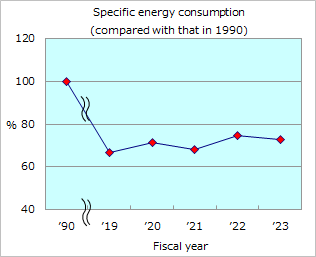
Changes in specific energy consumption
Measures against air pollution
Shikoku Operations is striving to reduce the amount of air pollutants generated from the boiler facilities and heating furnace. We are successfully keeping the emission of SOx, NOx and dust within the emission standards (*) by reducing the amount of heavy fuel oil used for the production, which could be achieved by using refinery gas by-produced from production processes using the equipment at the Operations plant, and by installing both flue-gas denitration and desulfurization units.
-

Changes in sulfur oxide (SOx) emission
-
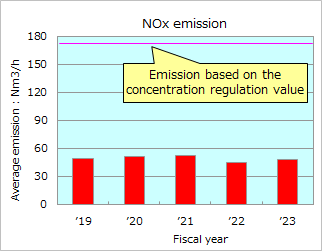
Changes in nitrogen oxide (NOx) emission
-
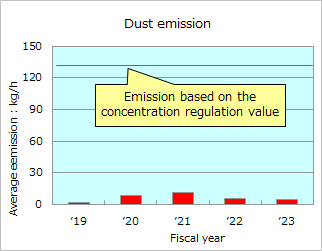
Changes in dust emission
- Emision standards: specified allowable volume or density limits that can be emitted.
Measures against water contamination
Shikoku Operations is striving to reduce the amount of water contaminants from the industrial effluent generated from plants in the Operations. We are successfully keeping the emission of COD (chemical oxygen demand), nitrogen and phosphorus within the allowable limits by using flocculation and sedimentation unit, biological treatment unit and activated carbon treater to treat the effluent.
-
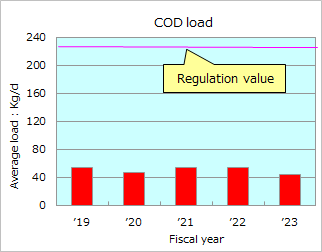
Changes in COD(Chemical Oxygen Demand)load
-
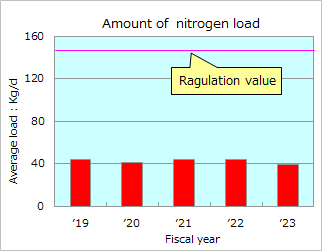
Changes in nitrogen load
-
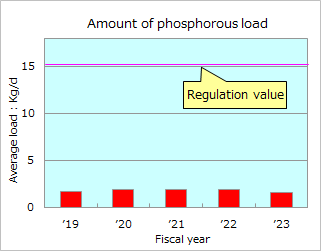
Changes in phosphorous load
Industrial waste and recycling measures
Shikoku Operations is working towards reduction in the amount of industrial waste, such as sludge, generated in the petroleum refining processes. Contractors are commissioned for the intermediate treatment of generated waste (reduction of the waste volume or recycling). The residue from the intermediate treatement is finally disposed of.
Management of chemical substances
Released and transferred quantity of substances defined in the PRTR system (for the fiscal year 2023)
Shikoku Operations is making every effort to maintain/continue to improve proper and effective control of chemical substances by compiling and analyzing the data on the quantity of released and transferred PRTR-specified substances. A vapor recovery unit, which was introduced in the onshore loading facilities in 2008, could successfully reduce the emission of volatile gases, including toluene and xylene.
(Unit: t/year)
| Substance number | Substance name | Emissions into the atmosphere | Emission into water bodies | Transferred quantity | Total |
|---|---|---|---|---|---|
| 53 | Ethylbenzene | 0.3 | 0.0 | 0.0 | 0.3 |
| 80 | Xylene | 3.2 | 0.0 | 0.0 | 3.2 |
| 132 | Cobalt | 0.0 | 0.0 | 3.0 | 3.0 |
| 300 | Toluene | 6.5 | 0.0 | 0.0 | 6.5 |
| 309 | Nickel | 0.0 | 0.0 | 0.7 | 0.7 |
| 321 | Vanadium | 0.0 | 0.0 | 2.2 | 2.2 |
| 392 | n-hexane | 16.0 | 0.0 | 0.0 | 16.0 |
| 400 | Benzene | 3.6 | 0.0 | 0.0 | 3.6 |
| 405 | Boron | 0.0 | 0.0 | 1.7 | 1.7 |
| 453 | Molybdenum | 0.0 |
0.0 |
8.6 | 8.6 |
| 691 | Trimethylbenzene | 1.3 |
0.0 |
0.0 | 1.3 |
- * If the total released and transferred quantity of a substance is below 0.1 t/year, the substance is omitted.
- (*)PRTR (Pollutant Release and Transfer Register) System It is a system, put in force since April 2001, in which the quantity of chemical substances that are potentially harmful to human health and to the ecosystem and that are emitted into the environment or transferred as contained in waste out of a business establishment is reported to the government once a year. This data is published by the government.